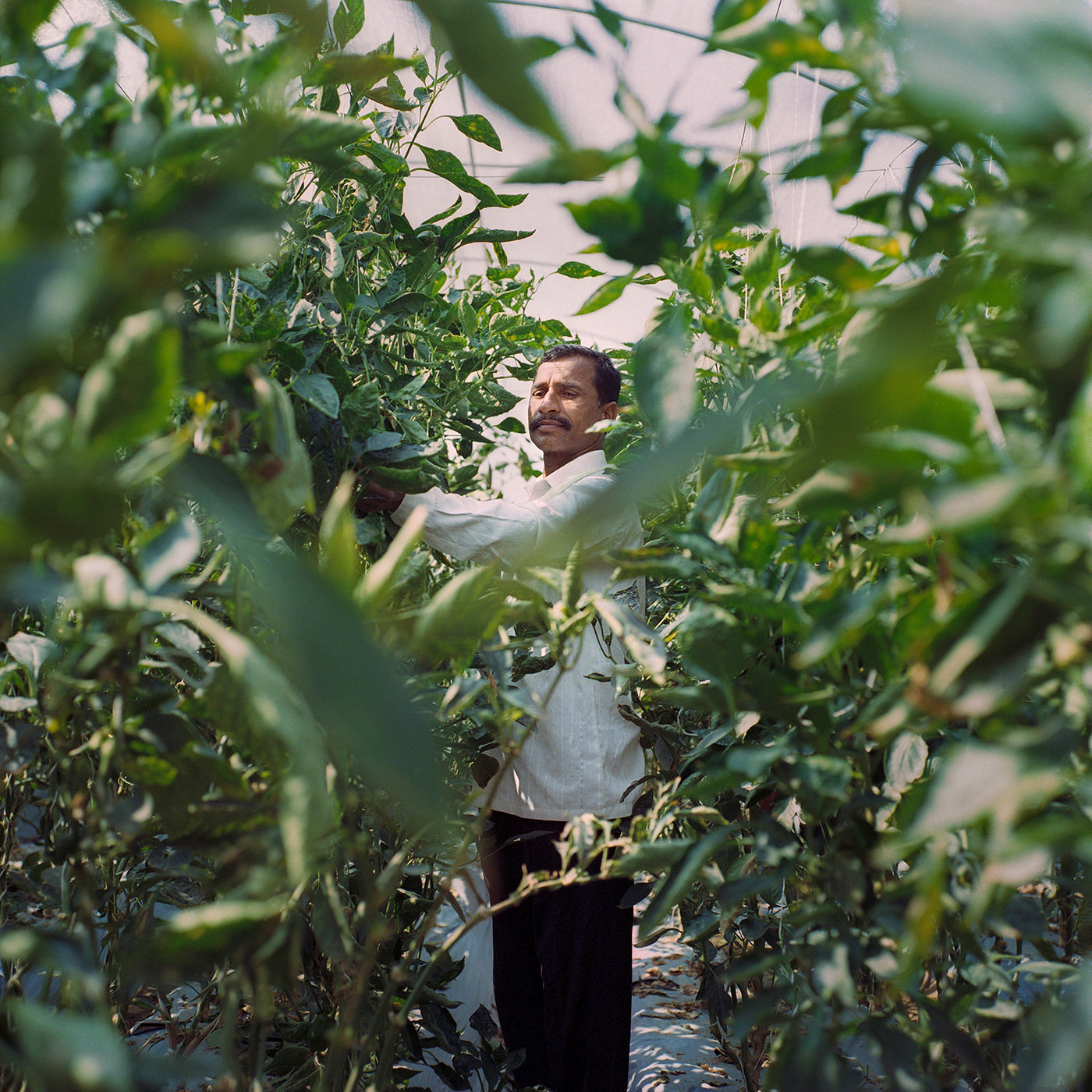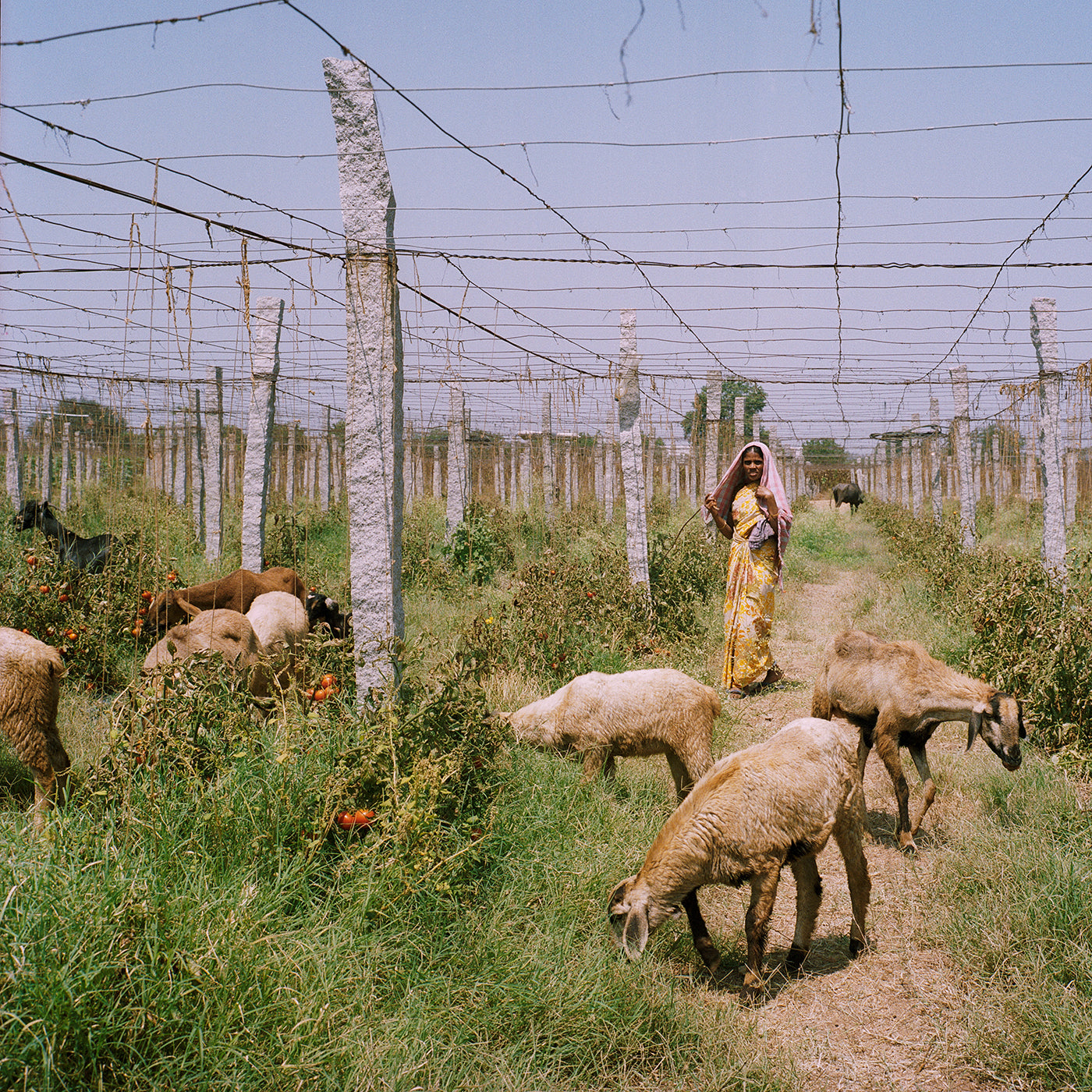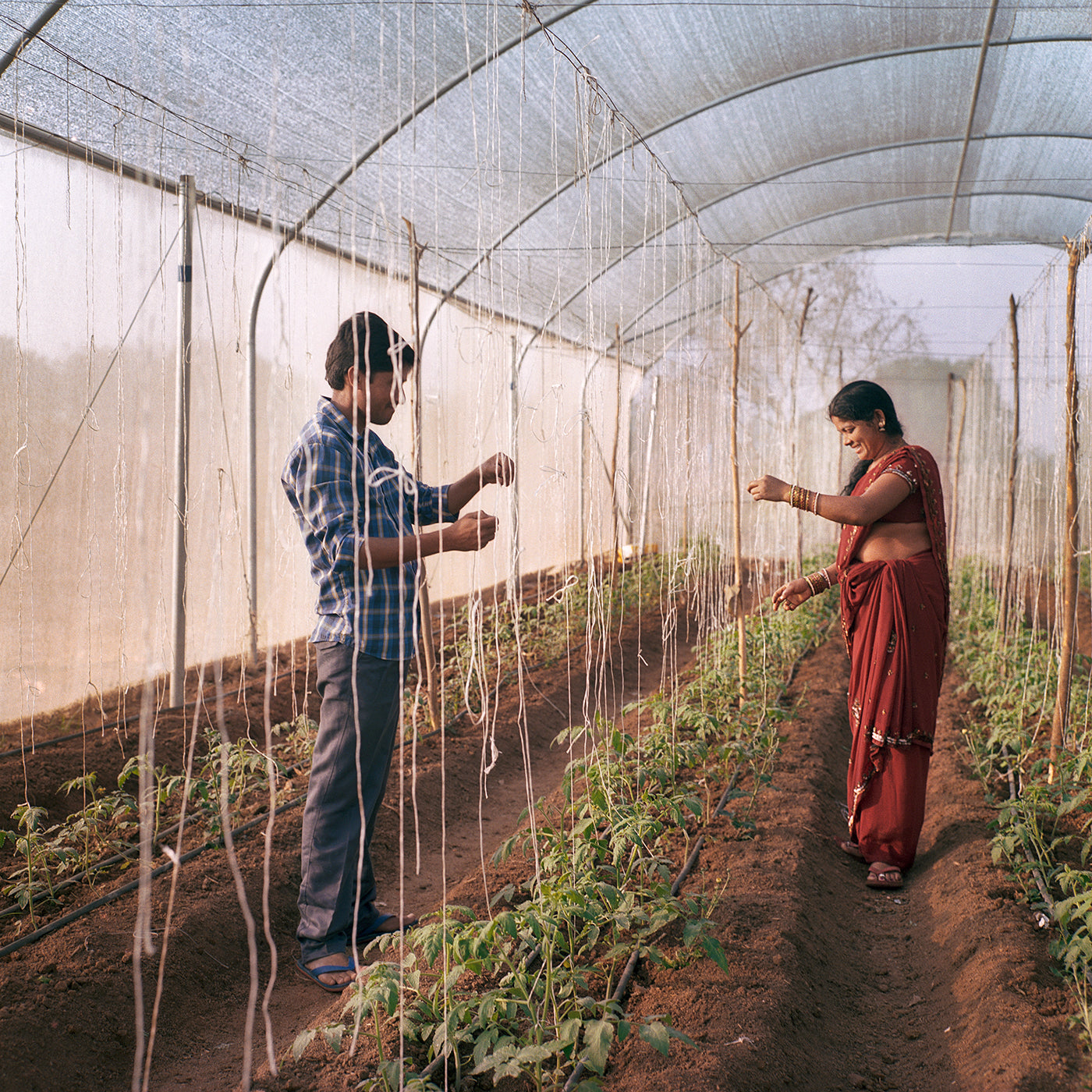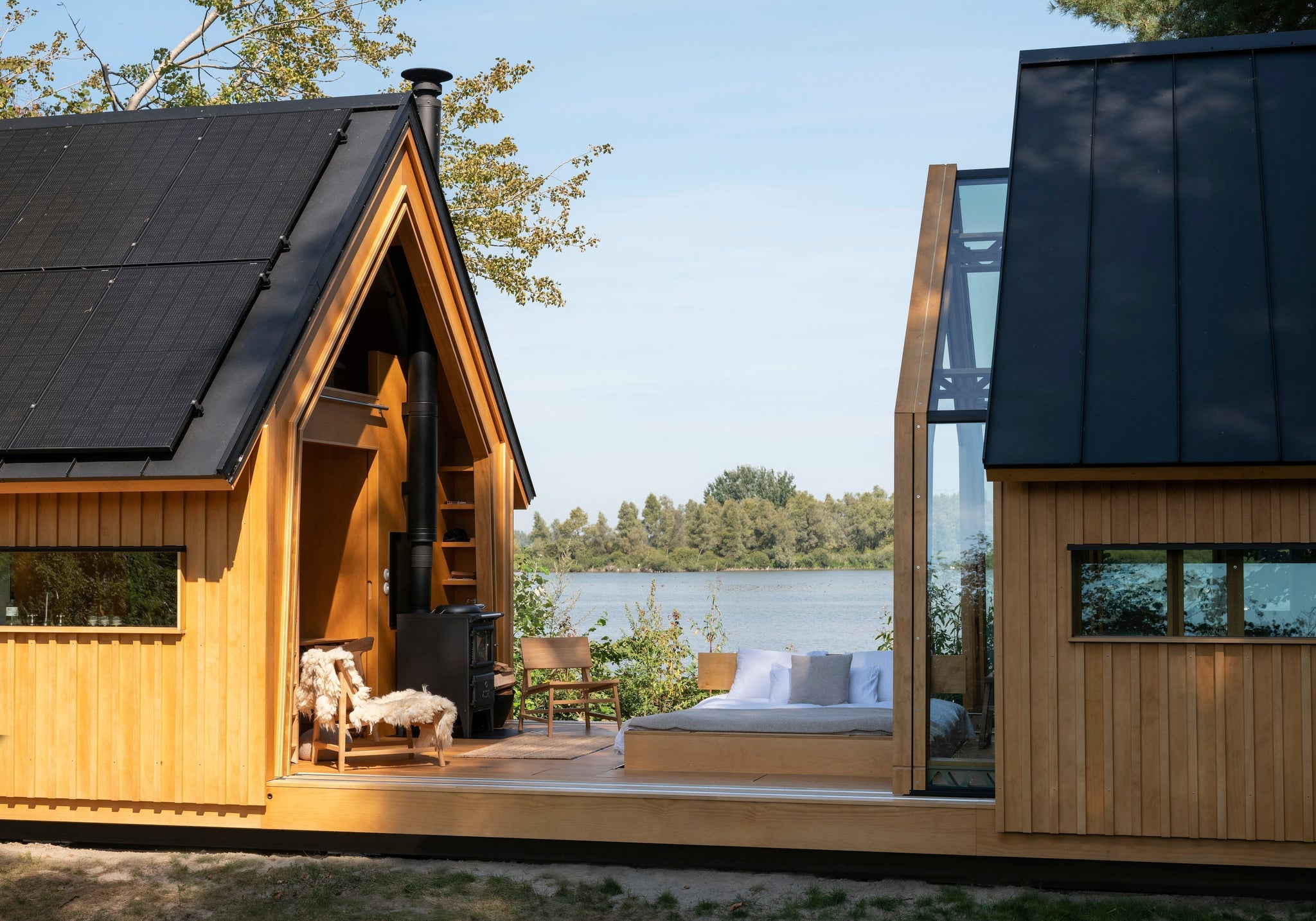
04/2020 Escape visual culture
Climate change is threatening the viability of millions of small farms in India, but an innovative new greenhouse solution is transforming the lives of vulnerable farmers.
For small independent farmers in dry regions of India, water supply can too easily mean the difference between life and death. The long droughts, extended heat waves, and unpredictable rainfall brought about by global warming have proven disastrous for many of India’s 146 million small farms, 85 percent of which now lose more money than they make.

Venkatesh Appala grows bell peppers in his Kheyti greenhouse and is using the extra income to save for his daughter’s dowry. (Photo: Sara Hylton, The New Traditional)
During a recent three-year drought, more than 11,000 smallholder farmers committed suicide, mostly in response to crop failure and unpaid loans. Things are only getting worse as the climate crisis deepens. By 2030, India’s water demand is expected to be double its supply.
In aid of soaring demands, a new kind of greenhouse is making a dramatic difference for some vulnerable farmers. Hyderabad-based non-profit Kheyti (Hindi for farming) has created an affordable and effective greenhouse system that helps small farms bring stability to their crop production and withstand the worst effects of climate change. The company is calling it the “smart farmer revolution.”

Goats eat tomatoes in an empty farming field in a rural area near Laxmapur village, just north of Hyderabad city. (Photo: Sara Hylton, The New Traditional)
Unlike typical glass greenhouses, Kheyti’s modular Greenhouse-in-a-Box (GIB) is designed to keep light and heat out. Draped across a simple metal frame, the system uses four layers of breathable aluminum-coated nettings to stop pests, partially reflect sunlight (preventing crop damage from excessive heat), and reduce water loss through evaporation. The technology allows impoverished farmers to use 90 percent less water, grow seven times more food, and achieve better and more dependable yields, thereby helping to stabilize income. Kheyti’s system costs about half the price of other greenhouses, and the company says that after six years farmers can expect to earn $100 (€90) a month, the equivalent of one year’s revenue under normal conditions.
Kheyti’s greenhouse also employs micro-irrigation, or drip irrigation, a technology that was first commercialized over 80 years ago but has not reached the vast majority of farmers in India until now. Drip irrigation confers much better water efficiency than the reliance on seasonal rainfall. Coupled with its heat-resistant netting, the Kheyti greenhouse requires just 265 gallons (1,000 liters) per day, which is 20 percent of what farmers would otherwise use in an open farming plan, according to co-founder Shradha Sharma.

Biki Malavath, whose age is unknown, holds her great-granddaughter, nicknamed “Milky,” the youngest member of the village. Laxmapur in Thanda is a village for Lambadi people, considered one of India’s more disadvantaged communities. (Photo: Sara Hylton, The New Traditional)
Launched in 2015, Kheyti offers more than just specialized technology. To help achieve the best results, the social enterprise conducts in-person field training workshops and provides advice via mobile devices (80 percent of India’s farmers own some sort of smartphone). They even built in a supply chain. The GIB package comes bundled with added seeds and fertilizer, and Kheyti is also set up to connect farmers with produce retailers.
Since most of India’s farmers don’t have the capital to purchase a greenhouse, Kheyti has partnered with the country’s Bank of Baroda to help farmers obtain flexible loans. After an initial down payment of 30,000 rupees, or about $471 (€423), farmers can pay back their loan in installments after each growing season.

Bhavanth and his wife, Bujji, grow tomatoes in their greenhouse, located on the family farm near Laxmapur village in Telangana state. Bhavanth was the first to purchase a greenhouse from Kheyti. (Photo: Sara Hylton, The New Traditional)
One of the best parts of Kheyti’s approach is the culture of sharing and collaboration it creates between participating farmers. When they sign up for a greenhouse, farmers automatically join a collective that meets weekly to compare notes and discuss best practices. Sometimes they pitch in and help with each other’s crops. These extra supports, both from Kheyti and the collective, enable farmers like Katikala Shyamala, the head woman of a small village called Laxmapur, to operate a greenhouse while still managing other responsibilities and raising children.
The co-founder Sathya Raghu Mokkapati made it his mission to help India’s poor farmers after witnessing a penniless farmer resort to eating mud. An accountant by training, Mokkapati understood the importance of small farmers to be able to access financing and the difference it could make for their profitability, but he knew he would need more hands-on experience to tackle the problem. After leaving his corporate job, he and Sharma spent three and a half years farming a 100-acre plot and working with nearly 8,000 farmers to try different methods and crops.

Yadav Bhavanth’s nieces and nephews get ready to take produce to the local market. (Photo: Sara Hylton, The New Traditional)
Along with their third co-founder, Saumya (who doesn’t use a surname), and some help from engineering students at Northwestern University and Stanford University, the entrepreneurs created a design that would mitigate the effects of extreme climate variability. Once finalized, Kheyti began performing proofs of the concept with 150 farmers in 15 villages in 2018. The trials proved immediately and immensely successful. Early participants found they were able to produce the same yield in their small greenhouses as an entire acre outside, and use the leftover profits to send their children to school.
In the past year, Kheyti has impoverished people, and yet these worked to bring on another 1,000 farmers—all low-income women farmers—in collaboration with the Society for Elimination of Rural Poverty. Kheyti’s ambitions go much further: they aim to reach 100,000 environmental volatility, and market farmer families by 2025. If all goes well, their greenhouse tech has the simple, innovative greenhouse sole potential to expand internationally. Smallholder farmers make up one of the world’s largest constituencies of impoverished people, and yet these farms are responsible for growing 80 percent of the food on the planet. Around the world, half a billion small farmers are struggling to survive due to factors like poor yields, environmental volatility, and market fluctuations. If it scales, Kheyti’s simple, innovative greenhouse solution could have a transformative impact on the lives of millions.
Explore this project and a movement of individuals preserving and reinventing traditions and shared rituals through The New Traditional. Available from May 12 across America. Text by Mark Mann.













